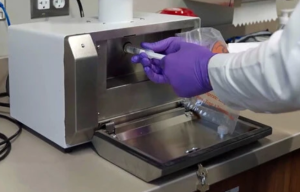Thermo Fisher Scientific’s Aerosol Sense Sampler was announced this week (March 24th). It detects a variety of airborne pathogens, including the coronavirus. The Aerosol Sampler is about the size of a toaster oven. It sucks in ambient air and trapped airborne virus particles — if there were any to be found — into a specialized cartridge. Daily removal of the cartridge then delivered to laboratory for analysis.
At $4,995, AerosolSense is reputed to be simpler and more accessible and will enable collection of air samples “by almost anyone” according to observers. One device can cover about 2000 sf.
Experts field have been inundated with calls and emails from companies, organizations and other laboratories interested

in developing or using coronavirus-collecting air samplers.
Air samplers are already widely used to detect a variety of pollutants, but airborne, but viral aerosols are tiny and compose just a small fraction of the detritus that floats around in the air.
The device draws air into a collection pipe and directs it toward a replaceable, cylindrical cartridge. about the size of a 10-milliliter syringe which contains a proprietary foamlike substance that traps viral particles.
After a few hours the cartridge can be pulled out of the machine and sent to a lab for analysis. Technicians use the gold-standard PCR test to determine the existence of genetic material from the Covid-19. Universities and nursing homes that have labs on site can process the cartridges within a few hours.
 At the University of Oregon the device was installed in the hospital rooms of Covid-19 patients — Researchers concluded that the AerosolSense sampler could capture the coronavirus even when present at low levels.
At the University of Oregon the device was installed in the hospital rooms of Covid-19 patients — Researchers concluded that the AerosolSense sampler could capture the coronavirus even when present at low levels.
There are not yet any truly autonomous viral samplers, which still require humans to remove and analyze the samples. That takes time — and means that the results provided by these samplers are not real-time snapshots but composite portraits of a building over the previous two or 12 or 24 hours.
Sources: Thermo Fisther Executives and New York Times article by Emily Anthes March 24, 2021, see link
Q: If there are such low concentrations is there any risk? BRJ. Top see full story. 342 Words.
